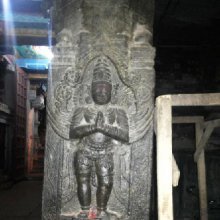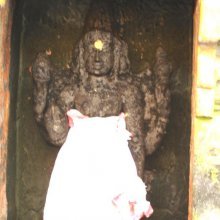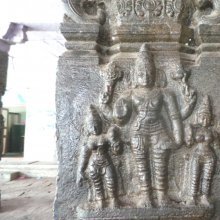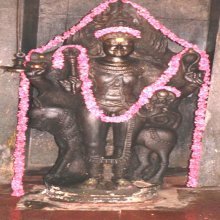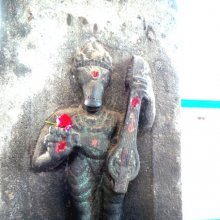Brahmasthana, Brahmasthāna, Brahma-sthana, Brahman-sthana: 13 definitions
Introduction:
Brahmasthana means something in Hinduism, Sanskrit, the history of ancient India, Marathi. If you want to know the exact meaning, history, etymology or English translation of this term then check out the descriptions on this page. Add your comment or reference to a book if you want to contribute to this summary article.
Images (photo gallery)
In Hinduism
Vastushastra (architecture)
Source: Google Books: The Hindu Temple, Volume 1The Brahmasthāna (ब्रह्मस्थान) is the place of God, Brahmā, the deific name and form of the Brahman, the Supreme Principle. This place of Brahman, in the heart of man, has its analogy in the Brahmasthāna, in the centre of the temple maṇḍala (or plan), where also lies the heart of the Vāstupuruṣa. This centre of the temple plan, has its equivalent in the Garbhagṛha where it does not coincide with it.
Source: Google Books: Consecration Rituals In South AsiaBrahmasthāna (ब्रह्मस्थान) or Brahmasthānasādhana refers to one of the chapters of the Devyāmata: an Early Śaiva Pratiṣṭhātantra dating back to the 5th century CE dealing with topics related to temple construction, consecration rituals, and iconography.—The Devyāmata is written in the form of a dialogue between Śiva and the Goddess. It begins with the praśnapaṭala, ‘the chapter on questions’, in which Devī tells Śiva what topics she would like to learn about. The answers are provided in the following chapters [e.g., brahmasthāna-sādhana], of which each is dedicated to one specific subject.
Source: The India Center: Architecture (Vastu Shastra)Brahmasthāna (ब्रह्मस्थान, “nuclear energy field”):—A square building with a grid of 3x3=9 squares. It should be kept unbuilt and open to the sky so as to have contact with the outer space (akasha). This central courtyard is likened to the lungs of the human body. It is not for living purposes. Religious and cultural events can be held here—such as yajna (fire rituals), music and dance performances and marriage.
The row of squares surrounding the Brahma-sthana is the walkway. The corner spaces, occupying 2x2=4 squares, are rooms with specific purposes. The northeast quarter is called Isanya, the southeast Agni, the southwest Niruthi and northwest Vayu. These are said to possess the qualities of four respective devatas or gods—Isa, Agni, Niruthi and Vayu.

Vastushastra (वास्तुशास्त्र, vāstuśāstra) refers to the ancient Indian science (shastra) of architecture (vastu), dealing with topics such architecture, sculpture, town-building, fort building and various other constructions. Vastu also deals with the philosophy of the architectural relation with the cosmic universe.
Purana and Itihasa (epic history)
Source: archive.org: Puranic EncyclopediaBrahmasthāna (ब्रह्मस्थान).—A holy place. It is mentioned in Mahābhārata, Vana Parva, Chapter 84, Stanza 103, that a person who visits this holy place will get the fruits of performing Aśvamedha yāga. (Horse sacrifice).
Source: Cologne Digital Sanskrit Dictionaries: The Purana IndexBrahmasthāna (ब्रह्मस्थान).—A place in the Vedi where brahmajyoti agni is located;1 here is viśvavyaca agni.2
Source: JatLand: List of Mahabharata people and placesBrahmasthāna (ब्रह्मस्थान) refers to the name of a Tīrtha (pilgrim’s destination) mentioned in the Mahābhārata (cf. III.83.32). Note: The Mahābhārata (mentioning Brahma-sthāna) is a Sanskrit epic poem consisting of 100,000 ślokas (metrical verses) and is over 2000 years old.

The Purana (पुराण, purāṇas) refers to Sanskrit literature preserving ancient India’s vast cultural history, including historical legends, religious ceremonies, various arts and sciences. The eighteen mahapuranas total over 400,000 shlokas (metrical couplets) and date to at least several centuries BCE.
India history and geography
Source: Cologne Digital Sanskrit Dictionaries: Indian Epigraphical GlossaryBrahma-sthāna.—(SII 13; SITI), explained as ‘an assembly hall’; the Brāhmaṇa quarters of a village; cf. Tamil pirumma- stānam (SITI), the quarters of the Brāhmaṇas where the village assembly (sabhā) used to meet. Note: brahma-sthāna is defined in the “Indian epigraphical glossary” as it can be found on ancient inscriptions commonly written in Sanskrit, Prakrit or Dravidian languages.

The history of India traces the identification of countries, villages, towns and other regions of India, as well as mythology, zoology, royal dynasties, rulers, tribes, local festivities and traditions and regional languages. Ancient India enjoyed religious freedom and encourages the path of Dharma, a concept common to Buddhism, Hinduism, and Jainism.
Languages of India and abroad
Marathi-English dictionary
Source: DDSA: The Molesworth Marathi and English Dictionarybrahmasthāna (ब्रह्मस्थान).—n S (Place of the production of brahma- dēva) A term for the navel.
Marathi is an Indo-European language having over 70 million native speakers people in (predominantly) Maharashtra India. Marathi, like many other Indo-Aryan languages, evolved from early forms of Prakrit, which itself is a subset of Sanskrit, one of the most ancient languages of the world.
Sanskrit dictionary
Source: DDSA: The practical Sanskrit-English dictionaryBrahmasthāna (ब्रह्मस्थान).—the mulberry tree.
Derivable forms: brahmasthānaḥ (ब्रह्मस्थानः).
Brahmasthāna is a Sanskrit compound consisting of the terms brahman and sthāna (स्थान).
Source: Cologne Digital Sanskrit Dictionaries: Monier-Williams Sanskrit-English Dictionary1) Brahmasthāna (ब्रह्मस्थान):—[=brahma-sthāna] [from brahma > brahman] n. ‘Brahmā’s place’, Name of a Tīrtha, [Mahābhārata]
2) [v.s. ...] m. the mulberry tree, [cf. Lexicographers, esp. such as amarasiṃha, halāyudha, hemacandra, etc.]
[Sanskrit to German]
Sanskrit, also spelled संस्कृतम् (saṃskṛtam), is an ancient language of India commonly seen as the grandmother of the Indo-European language family (even English!). Closely allied with Prakrit and Pali, Sanskrit is more exhaustive in both grammar and terms and has the most extensive collection of literature in the world, greatly surpassing its sister-languages Greek and Latin.
Kannada-English dictionary
Source: Alar: Kannada-English corpusBrahmasthāna (ಬ್ರಹ್ಮಸ್ಥಾನ):—
1) [noun] Brahma's place.
2) [noun] (arch.) the point in adytum (the innermost or central room in a temple) where the idol of the main deity is installed.
Kannada is a Dravidian language (as opposed to the Indo-European language family) mainly spoken in the southwestern region of India.
See also (Relevant definitions)
Partial matches: Brahman, Sthana, Brahma.
Starts with: Brahmasthanaka, Brahmasthanasadhana.
Full-text: Vishvavyaca, Brahmajyoti, Vishvadeva, Hathal, Sthanaka, Manushyalaya, Ayodhya, Samudra.
Relevant text
Search found 8 books and stories containing Brahmasthana, Brahmasthāna, Brahma-sthana, Brahman-sthana, Brahma-sthāna, Brahman-sthāna; (plurals include: Brahmasthanas, Brahmasthānas, sthanas, sthānas). You can also click to the full overview containing English textual excerpts. Below are direct links for the most relevant articles:
List of Mahabharata people and places (by Laxman Burdak)
The Skanda Purana (by G. V. Tagare)
Chapter 200 - Bhartṛyajña Prescribes Expiatory Rites < [Section 1 - Tīrtha-māhātmya]
Chapter 163 - Creation of Brāhma Nāgara [Community] < [Section 1 - Tīrtha-māhātmya]
Chapter 5 - Sages and Devas Residing in Prabhāsa Kṣetra < [Section 1 - Prabhāsa-kṣetra-māhātmya]
Varahi Tantra (English Study) (by Roberta Pamio)
Chapter 27 - The exposition on Mudrās and Bandhas < [Summary of the Vārāhī Tantra]
Early Chola Temples (by S. R. Balasubrahmanyam)
Temples in Velachcheri < [Chapter IV - Temples of Sundara Chola’s Time]
Temples in Kattumannargudi (Udaiyargudi) < [Chapter II - Temples of Parantaka I’s Time]
Shat-cakra-nirupana (the six bodily centres) (by Arthur Avalon)
Verse 49 < [Section 7]
The Brahma Purana (by G. P. Bhatt)
